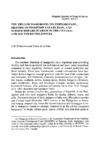The yellow mangrove: its ethnobotany, history of maritime collection, and needed rehabilitation in the central and southern Philippines
Share
Abstract
Most mangrove reforestation program in the Philippines and elsewhere in Asia focus on the genus Rhizophora, hence there is a need to identify and develop planting and harvesting techniques for other mangrove species, especially those in high demand by coastal communities. The yellow mangrove Ceriops tagal is one such species. Its many uses as firewood, poles for fish-corrals and traps, house construction, medicine (wound cleansing, treatment of hemmorhages), in the production of dyes (for dyeing fish nets, ropes, cloth and rice as a festive food) and as a mordant from bark are widely reported from the Philippines and all over Southeast and South Asia. An extensive sea-based industry for collecting C. tagal bark or tungog existed in the Philippines in the 1930s-1950s. It is heretofore described as undocumented industry including the boats used, collecting sites, markets, financing system and profit-sharing. Because C. tagal lacks reserve meristems, cutting of the trunk during bark gathering causes tree mortality. This explains the wholesale disappearance of the species from areas where it has been harvested throughout the Philippines, Southeast and South Asia, and East Africa. Research is needed to refine planting techniques and develop bark harvesting methods that do not kill the tree. Until nondestructive procedures for bark collection are finally perfected, C. tagal stands can be planted and harvested on a rotation basis.
Suggested Citation
Primavera, J., & de la Peña, L. (2000). The yellow mangrove: its ethnobotany, history of maritime collection, and needed rehabilitation in the central and southern Philippines. Philippine Quarterly of Culture & Society , 28(4), 464-475. http://hdl.handle.net/10862/1881
Subject
Collections
- AQD Journal Articles [1249]

